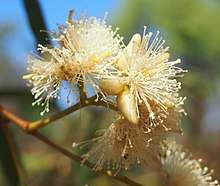Eucalyptus exserta
| Queensland peppermint | |
|---|---|
 | |
| Scientific classification | |
| Kingdom: | Plantae |
| Clade: | Angiosperms |
| Clade: | Eudicots |
| Clade: | Rosids |
| Order: | Myrtales |
| Family: | Myrtaceae |
| Genus: | Eucalyptus |
| Species: | E. exserta |
| Binomial name | |
| Eucalyptus exserta | |
| Synonyms | |
|
Eucalyptus insulana, F.M.Bailey | |


Eucalyptus exserta, commonly known as Queensland peppermint,[1] peppermint, bendo,[2] yellow messmate or messmate, is a tree native to New South Wales and Queensland in eastern Australia.[3][4]
Description
E. exserta can grow as a mallee to a height of 5 metres (16 ft) with a lignotuber or as a tree to a height of 20 metres (66 ft). It is covered in rough grey coloured bark, usually from the base to the small branches. The bark is hard, fissured and fibrous. The slightly glossy to dull usually green adult leaves are arranged alternately. The leaf blade has a narrowly lanceolate to lanceolate shape with a length of 6.5 to 18 centimetres (3 to 7 in) and a width of 0.7 to 2.7 cm (0.28 to 1.06 in). It produces axillary unbranched inflorescences with white flowers, followed by hemispherical fruit that are 0.2 to 0.7 cm (0.08 to 0.28 in) long and 0.4 to 0.8 cm (0.16 to 0.31 in) wide[4] with a raised disc and exserted valves.[3]
Taxonomy
The species was first formally described by the Victorian state botanist Ferdinand von Mueller in 1859 in the work Monograph of the Eucalypti of tropical Australia published in the Journal of the Proceedings of the Linnean Society, Botany.[5] The species name is from the Latin word exsertus meaning exserted, referring to the valves of the fruit.[4]
There are two known synonyms:
- Eucalyptus exserta var. parvula as described by William Blakely
- Eucalyptus insulana as described by Frederick Manson Bailey.[3]
Distribution and habitat
The species is found on stony rises and hills throughout much of central, southern and eastern[2] Queensland,[1] from around Charleville area east to the coast and then extending north to Mareeba. It is also found in a small area of northern New South Wales in the Bebo State Forest.[4] E. exserta grows in infertile sandy soils as part of dry sclerophyll woodland communities.[3]
It is a host tree for the mistletoe species Amyema miquelii, Dendrophthoe glabrescens and Dendrophthoe homoplastica.[6]
Cultivation and uses
E. exserta is a profuse flowerer and is of some importance as food for honeybees. It can be grown as a shade or windbreak tree on farms in areas where it is native, growing best on soils with good drainage.[7] E. exserta plantations were established in Guangdong Province in China to halt soil erosion in the early 1960s.[8][9]
See also
References
- 1 2 "Queensland peppermint – Eucalyptus exserta". WetlandInfo. Department of Environment and Science, Queensland. Retrieved 17 August 2018.
- 1 2 3 "Eucalyptus exserta". Austrahort. Retrieved 17 August 2018.
- 1 2 3 4 K.Hill. "New South Wales Flora Online: Eucalyptus exserta". Royal Botanic Gardens & Domain Trust, Sydney, Australia.
- 1 2 3 4 "Factsheet – Eucalyptus exserta". Euclid. CSIRO. Retrieved 17 August 2018.
- ↑ "Eucalyptus exserta F.Muell". Atlas of Living Australia. Global Biodiversity Information Facility. Retrieved 17 August 2018.
- ↑ Downey, Paul O. (1998). "An inventory of host species for each aerial mistletoe species (Loranthaceae and Viscaceae) in Australia" (PDF). Cunninghamia. 5 (3): 685–720. Archived from the original (PDF) on 25 April 2013.
- ↑ Elliot, Rodger W.; Jones, David L.; Blake, Trevor (1992). Encyclopaedia of Australian Plants Suitable for Cultivation: Vol. 4: Eu-Go. Port Melbourne: Lothian Press. p. 91. ISBN 0-85091-213-X.
- ↑ Yu Zuo Yue; Wang Zhu Hao; He Shao Yi. "Rehabilitation of eroded tropical coastal land in Guangdong, China". Journal of Tropical Forest Science. JSTOR. Retrieved 18 August 2018.
- ↑ Zheng Haishui (1987). "The Role of Eucalyptus Plantations in Southern China" (PDF). Multipurpose Tree species for small farm use. Winrock International Institute for Agricultural Development.